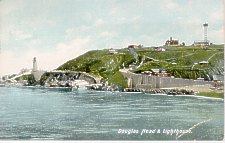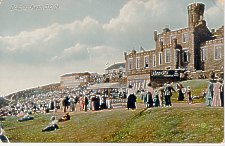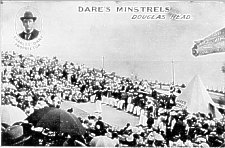
Edwardian Postcard View of Douglas Head c.1905
[the Warwick Revolving Tower was destroyed by fire August 1900]

Edwardian Postcard View of Douglas Head c.1905
[the Warwick Revolving Tower was destroyed by fire August
1900]
Douglas Head formed part of the Nunnery Estate but in 1870 Sir John Goldie-Taubman gave part of it to 'the people of Douglas' - initially Douglas Town Commissioners and later, after 1896, Douglas Corporation. A continuing theme in its first 50 years was the attempt by the authorities to prevent 'unsuitable' entertainments - gypsy encampments and fortune tellers were especially unwelcome.

Gypsy camp on Douglas Head road c. 1898.
Brown's Guide of 1877 had the following ramble dating from the start of the development of Douglas Head tourist attractions.
RAMBLE No. VI.Crossing the bridge, and following the South-quay as far as the Gas Works, or taking the nearest ferry to that point, we ascend Fort Anne-road, and passing Fort William, Fort Anne Tower, and the hotel, and arriving at the higher corner of the grounds attached to Ravenscliffe, we find a tablet in the wall directing our steps to Port Skillion Creek, a small sheltered cove, which has long been a favourite bathing-place for gentlemen. It has been considerably improved by Mr R. Archer, of Douglas, draper, who at an expense of nearly £1,000 has laid down concrete platforms to enable divers to plunge into deep water at various states of the tide, and has also erected private boxes for the bathers, in which towels, bathing dresses, &c., may be procured. A ferry boat also plies between Port Skillion and the Pier. Selecting a fine evening for this walk we turn down the little lane beyond Ravenscliffe and descend to a point over the Battery breakwater, where two walks diverge. The higher one leads to the battery of the Naval Reserve forces and to the battery of the late 1st I. O. M. Artillery Volunteers, from whence one footpath leads to the lighthouse and another to the hotel on Douglas Head. The lower walk conducts us by a wooden rail to the top of a flight of steps, well enough for active gentlemen and sprightly damsels in their teens, but not so easy of descent for the aged or the lame, and descending these steps, which are mostly cut from the rock, we find ourselves on the pebbly beach of Port Skillion, with huge rocks towering on high on either hand. Passing on through the creek we ascend a few steps on the farther side, and follow a footpath which comes from the hill above and leads to the lighthouse--a substantial structure built in 1833, and showing a light visible at fourteen miles distance. A little further on is a precipitous cliff, which dips down abruptly into the sea, and over which, it is said, criminals of a certain class were thrown into the sea, first being tied up in sacks to prevent all possibility of escape. The following tradition is also related concerning a cliff in the neighbourhood :—" About half way up this cliff is a hollow resembling an elbow chair, and near the top another cavity nearly similar. On the slightest accusation some poor nun was brought to the foot of this rock when the sea had ebbed, and was obliged to climb to the first chair, where she had to remain until the tide had flowed and ebbed twice. Those who had given a greater cause of suspicion were obliged to ascend to the second chair, and to sit there for the same length of time. Anyone who endured this trial, and descended unhurt, was cleared of all aspersion that had been thrown upon her. Such a lengthened exposure to the elements so far above the level of the sea probably occasioned the death of many of these unfortunate creatures." Well ! we should think so, if the tradition be true; but many of the tales respecting monks and nuns are but fabrications of bigoted and intolerant minds. From the lighthouse and adjacent rocks a steep footpath may be climbed to the hotel on the Head, from whence a good road leads down to Douglas. This hotel commands a magnificent view of Douglas Head the adjacent country as well as of the bay.
[FPC - the comments re nun's chair etc are of course nonsense]
A more extended description was also given by Jenkinson in his 1874 guide.
The Head rapidly became very popular

Robert Archer had completed his baths in 1874, possibly the first open air swimming pool in the British Isles. Intended for gentlemen only - it would appear to have drawn an appreciative female audience. Mixed bathing was a thing of the future - bye laws of 1886 gave the commissioners power to regulate bathing machines including separation between the sexes.
These baths were among the first of many attractions that were built on the Head - the Douglas Head Hotel dates from around 1870. Toboggan slides and other attractions soon followed - a Camera Obscura was built in 1886. In 1896 the Marine Drive Tramway opened offering a breathtaking ride to Port Soderick where it met the Douglas-Port Erin steam railway and which was then also developed as a tourist resort. In 1897 and 1898 inclined lifts were added at each end of the Tramway.
Other attractions on the head were the minstrels

Dare's Minstrels (postmarked 1904)
The view shows the now highly politically incorrect blacked-up minstrel band common in the period - a later postcard of 1910 shows the band in naval uniforms. Charles Dare from Greenwich and his 'Anglo-American' Minstrels were the main minstrel troupe on the Head - although he paid rent to Douglas Corporation he relied on voluntary contributions from the audience and from sales of his song books to pay his way.
Later views show a more substantial stage and rows of seating at the same spot - open air shows continued here until the 1970's.
Brown's guide of 1906 describes the many more attractions:
Every visitor to Douglas pays at least one visit to Douglas Head, calling at Port Skillion on his way, to bathe in the crystal clear waters of the outer bay, if a lover of " The briny ; " and if he has passed that stage of existence, to watch those who do bathe in that most popular of bathing creeks. The vast majority of Douglas visitors "go up the Head," as often as they find themselves with an hour or two unoccupied ; for access to it across the Outer Harbour is so easy and pleasant, the air upon its summit is so fresh and invigorating, the prospects from it are so diversified and far-reaching, and the amusements to be there found are so many and so generally enjoyable that the place never becomes stale or wearisome. From the earliest days of Douglas as a watering place, Douglas Head has been one of its most popular resorts, and, so far from its popularity declining with the growth of other attractions, it has steadily grown year by year, and is now more popular and more frequented than ever.To reach the Head, we have a choice of roads. We may proceed by way of Douglas Bridge and the South Quay to the Head Road, into which we turn at the Gas Works. Or we may cross the harbour by the New Swing Bridge, and mount the steps in the Head-road, or we may walk round by the Approach-road to the Battery Pier. Or lastly, and this is at once the pleasantest and most popular way of " getting there," we may cross the Outer Harbour in one of the steam ferry boats ; and passing behind the root of the Battery Pier mount the headland by a well made zig-zag road, formed by Mr. Robert Archer, of Douglas, in connection with his favourite scheme of a bathing place at Port Skillion.
....
DOUGLAS HEAD.
The climb to the top of the Head, from Port Skillion, is somewhat steep and difficult ; but it can be broken at any point by sitting down on the grassy hill side, and while resting, enjoying the beautiful prospect of the town and bay. Just before reaching the summit we may follow a path to the left which will bring us to the Lighthouse. This building is open to the public, under reasonable restrictions; and an inspection of its interior is very interesting.
The summit of the Headland is 320 feet above the sea, and the views from it on all sides are wide and diversified; while its own immediate scenery is equally interesting to the man of science as it is to the mere tourist and pleasure seeker. Upon its highest point is a picturesque group of buildings forming the Douglas Head Hotel ; the central portion of which is an old tower, one of a series of land marks placed on prominent points of the coast, as guides to vessels out at sea. In the Hotel, is an interesting collection of curiosities ; an examination of which will richly repay the visitor. Upon the open space surrounding the Hotel, there are numerous popular forms of amusement, mostly of an "out of doors" character—negro minstrels, mandolinists, vocalists, photographers, itinerant lecturers upon phrenology, palmistry, electricity, and many other ways of passing an idle hour pleasantly. These heterogeneous amusements are all under the supervision of the Douglas Town Council ; and an inspector under the Council is always on the spot to preserve order and good conduct.
But probably the greatest attractions of Douglas Head are its beautiful outlook and its clear crisp air—attractions which neither time nor frequency of enjoyment can lessen or make stale. Looking to the northward and westward, the town and bay and the country side beyond lie spread out before us like a map—the breakwater, the jetty, the old and the new piers, are all seen deep down below, jutting out into the bay ; and beyond the new pier is the Tower of Refuge, picturesquely placed on the Conister Rock. On the steep hill side, half hidden among their sheltering woods, are Harold Tower, once the home of Martin, the painter; Ravenscliffe, formerly the summer residence of Edward Binney the geologist ; Fort Anne Hotel, where Sir Wm. and Lady Hillary lived, and planned the erection of the Tower of Refuge ; while across the narrow harbour, are the buildings of the town, closely massed together in the Old Town, and stretching out ever extending arms northward and west-ward along the margin of the bay and up the rising grounds above it. Beyond these, in the distance, are the rocky coastline to Clay Head, and the hills of Onchan and Braddan sloping upward into the dark mountains of the interior, the whole range of which is seen from the Bradda Hills to North Barrule above Ramsey. The outlook from this " point of vantage " is a striking one, equalled by few others in the British Isles.
The cliffs of Douglas Head, and of the coast to the south are magnificent examples of coast scenery ; and are interesting alike from their height, their fantastic forms, and from their extraordinary scientific value. To the ordinary tourist, it is an ideal delight on a bright summer day to re dine on some grassy slope, and gaze out at the long line of black, weather worn cliffs, with the quiet sea beating murmurously against their broken base in a broad band of snow white surf, and surge in and out of the caves and winding passages with which they are honeycombed. About half a mile beyond the lighthouse, is a pretty little creek named Pigeon’s Cove ; and close to it is an opening, called Quirk’s Cove, in which, about sixty years ago, an eccentric character, a shoemaker named Quirk, lived for some time. A little further on is a narrow cleft in the rocks known as the Horse Leap, down which tradition says, a hare went, fol lowed by a whole pack of dogs ; a man on horseback barely saving himself by leaping the gulf. Near the Horse Leap, are the Nun’s Chairs, two water worn rocks roughly re seinbling arm chairs ; in which it is said, the nuns of St. Bridget’s Nunnery were punished for infractions of one convent rules. These and other points of this coast can be reached by way of the Douglas Head Marine Drive, a well constructed road over the Head land to Port Soderick upon which an electric tramway has now been laid, or in a small boat from Douglas. The latter is the better way for those who can enjoy a pleasant sail along a wild rock bound coast, accompanied by some good fishing. To the geologist this part of the Manx coast is wonderfully rich in examples of the effects of shrinkage and of igneous action ; the strata being thrown up at all angles, and contorted and twisted in a most extraordinary manner—sections only a few inches in length often showing a succession of deep foldings of the strata. To the naturalist and the botanist, thIs district is almost equally interesting ; while the antiquarian, as we have seen, will find numerous points of peculiar interest in it.
G. Kniveton (et al) Douglas Centenary (ISBN 1-873120-21-4) 1996 pp43/47
|
|
||
|
Any comments, errors or omissions
gratefullyreceived The
Editor |
||